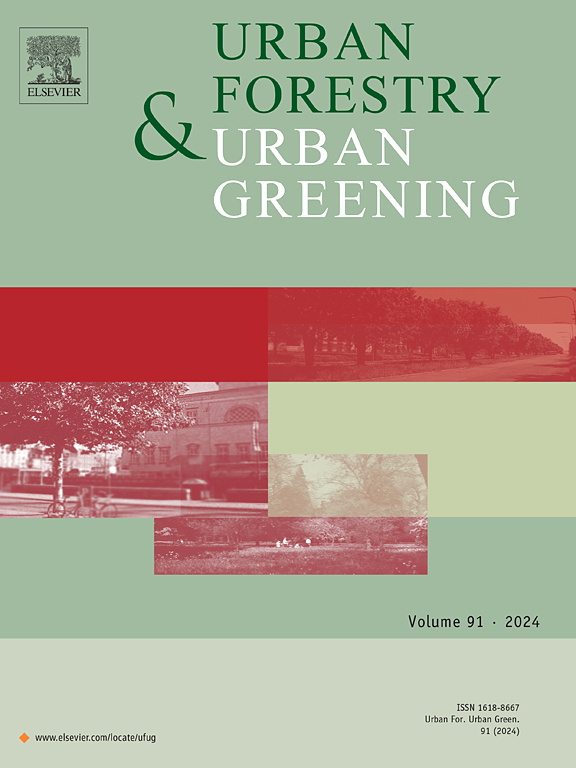The relationship between local patch landscape patterns and bird community traits along the urbanization gradient
IF 6
2区 环境科学与生态学
Q1 ENVIRONMENTAL STUDIES
引用次数: 0
Abstract
As global urbanization accelerates, urban ecosystems undergo profound transformations, necessitating deeper investigations into the ecological effects of urban green patches at varying local scales and their impact on bird community distributions. This study explores the influence of landscape characteristic indices across nine distinct patch types along the urbanization gradient on bird community dynamics at multiple buffer radii. A comprehensive, year-long survey was conducted across 23 sample sites, classifying patches into nine coverage types. Landscape indices were calculated at three buffer scales, and their correlation with bird community characteristics was analyzed, alongside comparisons between regions with differing levels of urbanization. The findings reveal that patch types and their landscape characteristics exert significant, scale-dependent effects on bird diversity and stability. In low-urbanized areas, the area and edge density of tree patches within 100–200 m buffer zones play a crucial role in enhancing bird community characteristics. In highly urbanized areas, the connectivity between small shrubland patches and agricultural land at the 50 m buffer scale is vital for bird survival. Vegetated water patches enhance bird diversity by improving connectivity between patches at different scales, forming an effective network structure. Building patches also make significant contributions to bird diversity. Even at the local scale, urban bird community characteristics are shaped by the combined effects of landscape structure and patch characteristics across multiple buffer scales, with these effects becoming increasingly pronounced as urbanization intensifies.
城市化梯度下斑块景观格局与鸟类群落特征的关系
随着全球城市化进程的加快,城市生态系统正在发生深刻的变化,有必要深入研究不同地方尺度的城市绿地的生态效应及其对鸟类群落分布的影响。本研究探讨了沿城市化梯度的9种不同斑块类型的景观特征指数对多个缓冲半径上鸟类群落动态的影响。在23个样本地点进行了为期一年的全面调查,将斑块分为9种覆盖类型。计算了3个缓冲带尺度的景观指数,分析了景观指数与鸟类群落特征的相关性,并比较了不同城市化水平区域间的差异。研究结果表明,斑块类型及其景观特征对鸟类多样性和稳定性具有显著的尺度依赖性。在低城市化地区,100-200 m缓冲带内树木斑块的面积和边缘密度对鸟类群落特征的增强起着至关重要的作用。在高度城市化地区,50 m缓冲尺度的小灌木斑块和农田之间的连通性对鸟类的生存至关重要。植被水斑通过提高不同尺度斑块之间的连通性,形成有效的网络结构,增强了鸟类多样性。建筑斑块也对鸟类多样性做出了重要贡献。即使在局部尺度上,城市鸟类群落特征也受到景观结构和斑块特征在多个缓冲尺度上的综合影响,并且随着城市化的加剧,这种影响越来越明显。
本文章由计算机程序翻译,如有差异,请以英文原文为准。
求助全文
约1分钟内获得全文
求助全文
来源期刊

Urban Forestry & Urban Greening
FORESTRY-
CiteScore
11.70
自引率
12.50%
发文量
289
审稿时长
70 days
期刊介绍:
Urban Forestry and Urban Greening is a refereed, international journal aimed at presenting high-quality research with urban and peri-urban woody and non-woody vegetation and its use, planning, design, establishment and management as its main topics. Urban Forestry and Urban Greening concentrates on all tree-dominated (as joint together in the urban forest) as well as other green resources in and around urban areas, such as woodlands, public and private urban parks and gardens, urban nature areas, street tree and square plantations, botanical gardens and cemeteries.
The journal welcomes basic and applied research papers, as well as review papers and short communications. Contributions should focus on one or more of the following aspects:
-Form and functions of urban forests and other vegetation, including aspects of urban ecology.
-Policy-making, planning and design related to urban forests and other vegetation.
-Selection and establishment of tree resources and other vegetation for urban environments.
-Management of urban forests and other vegetation.
Original contributions of a high academic standard are invited from a wide range of disciplines and fields, including forestry, biology, horticulture, arboriculture, landscape ecology, pathology, soil science, hydrology, landscape architecture, landscape planning, urban planning and design, economics, sociology, environmental psychology, public health, and education.
 求助内容:
求助内容: 应助结果提醒方式:
应助结果提醒方式:


